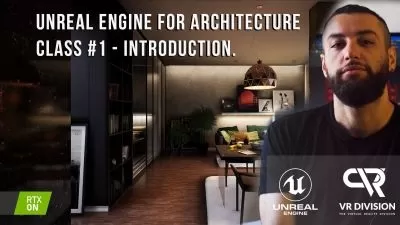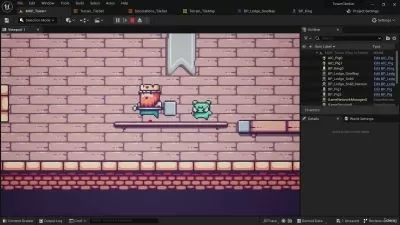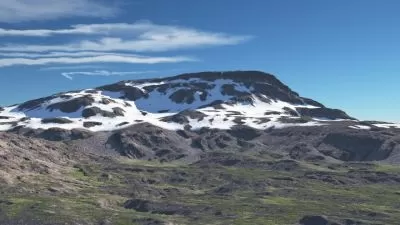Blender to Unreal Engine 3D Plants and Vegetation
3D Tudor
15:34:58
Description
Complete Guide To Learning How To Create Foliage & Plants in Blender and Then Export to Unreal Engine 5
What You'll Learn?
- • Enjoying the foliage modelling to game environment transition from Blender to Unreal Engine 5 - the only one out there like it
- • Creating 12 different foliage types with over 30 variations, including plants, grass, water lilies, and reeds to create environments unique to every student
- • Using Blender 3 and understanding its new interface and shortcuts
- • Maximising the potential of your references to develop strong game asset concepts using Pureref
- • Importing and setting up custom alpha brushes for texture painting
- • Creating vegetation from a simple plane and turning it into 3D foliage (i.e., modeling from a 3D plane)
- • Making use of Blender’s particle system to model foliage including flowers
- • Using weight painting techniques to get better control over foliage position
- • Learning how to create clusters of foliage to get the best results in an environment
- • Learning how to use HDRIs as 3D model backgrounds for your portfolio
- • Utilising rendering to improve the quality of presentation for your 3D environment by rendering out in Blender’s rendering engine Cycles
- • Choosing to continue your 3D modelling to game engine journey by completing the second (independent) part of the course in Unreal Engine 5
- • Optimising 3D foliage ready to export them into Unreal Engine 5
- • Preparing foliage asset collections for UE5 integration and setting up material instances for them
- • Exploring different transparency materials that will help you set up cut-out decals, partially transparent decals with PBR values and two side-faced textures
- • Creating materials for the foliage using UE5 texture customisation and the wind system
- • Learning how to paint water foliage into a scene and how to get more depth out of its volume, painting plants on top of the water, inside the water, and under
- • Setting up a foliage asset pack that can be easily imported onto any Unreal Engine 5 project
- • Presenting your foliage pack in an Unreal Engine 5 prepared environment (provided in the course resources)
- • Complete the course which is going to be the first stepping stone to creating different 3D worlds
Who is this for?
More details
DescriptionHave you ever wanted to breathe life into your game world through foliage like plants, grass, water lilies and reeds?
'Blender to Unreal Engine 3D Plants and Vegetation' is very different to any other 3D modeling course out there! Our focus is to create an entire foliage pack completely made in Blender - one of the top open-source and free 3D modeling software out there.
We will not be using any other software to create all that you see in the thumbnail, except Blender. You will also learn about plant and grass animation, and as an added plus, you will learn about how to integrate foliage into a game engine - Unreal Engine 5.
This is great because it means you will get to see how we make foliage from scratch and import it into video games. I am sure 'Blender to Unreal Engine 3D Plants and Vegetation' will be the one course that you will want to keep handy anytime you need to create variations of foliage.
Our 'Blender to Unreal Engine 3D Plants and Vegetation' top 6:
1.  Creating vegetation from a simple plane and turning it into a 3D foliage (i.e., modeling from 3D plane)
2.  Making use of Blender’s particle system to model foliage including flowers
3.  Learning about optimisation and the importance of low poly modeling to get a best performace out of a dense foliage setup within any scene at the same time as maintaining the stylized visuals of custom painted foliage
4.  Using weight painting techniques to get better control over foliage position
5.  Creating materials for the foliage using UE5 texture customisation and the wind system
6.  Learning how to paint water foliage into a scene and how to get more depth out of its volume, painting plants on top of water, inside the water, and underwater
Now, there are courses out there that can show you how to create grass that reacts to wind, but there is nothing that covers the entire process from flowers and plants to grass, and even water lilies and reeds. 'Blender to Unreal Engine 3D Plants and Vegetation' is intended to be the complete guide to creating foliage in Blender.
Blender: 3D Modeling
'Blender to Unreal Engine 3D Plants and Vegetation’ will see you creating 12 different types of foliage with over 30 variations. We start our journey from a simple cube and we through all the techniques you will need to create flowers and stems. This will include low poly modelling techniques as well as more advanced Blender functions using the Bezier curve functions.
As we progress through 'Blender to Unreal Engine 3D Plants and Vegetation', we will be increasing the difficulty of the foliage we are creating. You will also be learning about the most fundamental 3D modelling skills, including how to properly UV plants ready for adding materials to them.
You will be learning about Blender's powerful texture painting workflow. I will be supplying some of my very own custom alpha brushes which you can use in your 3D models and scenes. The texture painting part of 'Blender to Unreal Engine 3D Plants and Vegetation' is huge and has a lot of depth to cover, showing you everything available in Blender. This includes custom brushes, cavity masking, and different map types.
'Blender to Unreal Engine 3D Plants and Vegetation’ will introduce you to particle system setups. This will show you how to populate an area with plants and grass in a natural way, with complete control over placement and smaller variations.
Blender: Animation
Finally, creating your foliage pack which will include grass, flowers and stems, reeds, and water plants, you will be animating all parts using Blender.
We will be going through the entire process of bringing the foliage to life by creating realistic movement. This will consist of adding wind and turbulence to our blender scene.
This will add a massive amount of realism to any Blender renders you might create using the foliage you created in 'Blender to Unreal Engine 3D Plants and Vegetation'.
Best of all, we will also be covering how to light your scene using real-world lighting techniques. To finish off the Blender section, I will be showing you the correct way of exporting foliage to game engines like Unreal Engine 5.
Unreal Engine 5: Game Engine Integration
This section of 'Blender to Unreal Engine 3D Plants and Vegetation' has as much depth as the Blender part. We will cover everything from importing foliage to setting up vertex painting and creating materials. Finally, we will be looking into the foliage tools available in Unreal Engine 5 (UE5), including setting up realistic wind animations.
You will become a master of using the foliage tool in Unreal Engine 5 (UE5). With it, you will be able to set up foliage with all of its settings. You will find out how to change and randomise scale, how to change allignment, and how to make adjust foliage density to achieve nice variation over an entire foliage painting process.
Finally, the Unreal Engine 5 (UE5) part includes a full environment scene composition guide for to enhance your environment without cluttering up the terrain.
Since 'Blender to Unreal Engine 3D Plants and Vegetation' has two parts based on Blender and Unreal Engine 5 (UE5) respectively, your UE5 milestone project will be to present your foliage set in Unreal Engine 5 using a prepared environment included in the course resources and render out a scene.
'Blender to Unreal Engine 3D Plants and Vegetation' is unique because all the foliage is made entirely in Blender. That means it can all be created entirely for free once you realize the true power of this amazing software.
So, come join me on this amazing course and you will never be stuck again when it comes to bringing your scene to life!
Your project will be to model, texture, animate, and optimise 12 different types of foliage with over 30 variations. Of course, you could set yourself a challenge and diversify aspects or details of foliage like plants, grass, water lilies and reeds. You could change the textures, and add different variations or more types of plants, such as different wall-climbing plants, bushes, and shrubbery, to make your environments more alive.
I imagine you using flowers, plants, water lilies and reeds in the fields surrounding the farm in 3D Tudor’s ‘Blender 3 The Ultimate Medieval Scene Course’!
To get you pumped, imagine how well this 3D foliage set fits in with your other 3D Tudor projects.
Be creative! Feature your foliage set around a medieval castle keep with ‘Creating a Modular Kitbash in Blender’. Also, think about using them in other medieval environments such as:
- Around a gipsy carriage in ‘Substance Painter to Unreal Engine 5 Masterclass’;
- All around the ‘Unreal Engine 5 Beginners Guide to Building an Environment Course’ course scene to transform its landscape;
- Next to a river running by a medieval wind and water mill hybrid with ‘Blender to Unreal Engine 5 Ultimate Course’, or;
- To populate and make ‘Blender 3D Modelling & Animating A Stylized Oriental Scene’ even more beautiful.
This course will give you access to just over 15 hours of 3D art in around 82 comprehensive lessons.
Course Resources & Freebies
The 'Blender to Unreal Engine 3D Plants and Vegetation’ resource pack includes 6 custom brushes (alpha textures and other Blender preset formats), 9 image references and a Pureref reference file, and an environment example (.blend file and .fbx file inclusive of 15 textures).
Join this course and come be part of a game design journey of over 15 hours of learning that will see you creating all the foliage you might want in just 82 lessons.
I am excited for you to share your renders and turntables of how you used your foliage in different environments for your portfolios with me. Go beyond the taught material and make new foliage types to represent the flora of different continents.
Check out the free introduction and I am sure you won’t be able to put this course down!
Until next time, happy modelling everyone!
Neil – 3D Tudor
Who this course is for:
- • Beginner 3D modellers eager to learn how to build 3D foliage such as plants, lily pads, underwater plants, reeds, shrubs, grass, and much more
- • Enthusiasts of Blender who want to fast-track their understanding of its new and exciting changes
- • Mid-Level 3D modellers who want to take their modelling to a new level and improve their workflow with tips and tricks
- • Fantasy and open-world game environment fans who want to walk through and experience a realistic environment
- • Game designers who would like to design a set of over 12 different types of foliage and 30 variations for a myriad of game environments for games in Unreal Engine 5
Have you ever wanted to breathe life into your game world through foliage like plants, grass, water lilies and reeds?
'Blender to Unreal Engine 3D Plants and Vegetation' is very different to any other 3D modeling course out there! Our focus is to create an entire foliage pack completely made in Blender - one of the top open-source and free 3D modeling software out there.
We will not be using any other software to create all that you see in the thumbnail, except Blender. You will also learn about plant and grass animation, and as an added plus, you will learn about how to integrate foliage into a game engine - Unreal Engine 5.
This is great because it means you will get to see how we make foliage from scratch and import it into video games. I am sure 'Blender to Unreal Engine 3D Plants and Vegetation' will be the one course that you will want to keep handy anytime you need to create variations of foliage.
Our 'Blender to Unreal Engine 3D Plants and Vegetation' top 6:
1.  Creating vegetation from a simple plane and turning it into a 3D foliage (i.e., modeling from 3D plane)
2.  Making use of Blender’s particle system to model foliage including flowers
3.  Learning about optimisation and the importance of low poly modeling to get a best performace out of a dense foliage setup within any scene at the same time as maintaining the stylized visuals of custom painted foliage
4.  Using weight painting techniques to get better control over foliage position
5.  Creating materials for the foliage using UE5 texture customisation and the wind system
6.  Learning how to paint water foliage into a scene and how to get more depth out of its volume, painting plants on top of water, inside the water, and underwater
Now, there are courses out there that can show you how to create grass that reacts to wind, but there is nothing that covers the entire process from flowers and plants to grass, and even water lilies and reeds. 'Blender to Unreal Engine 3D Plants and Vegetation' is intended to be the complete guide to creating foliage in Blender.
Blender: 3D Modeling
'Blender to Unreal Engine 3D Plants and Vegetation’ will see you creating 12 different types of foliage with over 30 variations. We start our journey from a simple cube and we through all the techniques you will need to create flowers and stems. This will include low poly modelling techniques as well as more advanced Blender functions using the Bezier curve functions.
As we progress through 'Blender to Unreal Engine 3D Plants and Vegetation', we will be increasing the difficulty of the foliage we are creating. You will also be learning about the most fundamental 3D modelling skills, including how to properly UV plants ready for adding materials to them.
You will be learning about Blender's powerful texture painting workflow. I will be supplying some of my very own custom alpha brushes which you can use in your 3D models and scenes. The texture painting part of 'Blender to Unreal Engine 3D Plants and Vegetation' is huge and has a lot of depth to cover, showing you everything available in Blender. This includes custom brushes, cavity masking, and different map types.
'Blender to Unreal Engine 3D Plants and Vegetation’ will introduce you to particle system setups. This will show you how to populate an area with plants and grass in a natural way, with complete control over placement and smaller variations.
Blender: Animation
Finally, creating your foliage pack which will include grass, flowers and stems, reeds, and water plants, you will be animating all parts using Blender.
We will be going through the entire process of bringing the foliage to life by creating realistic movement. This will consist of adding wind and turbulence to our blender scene.
This will add a massive amount of realism to any Blender renders you might create using the foliage you created in 'Blender to Unreal Engine 3D Plants and Vegetation'.
Best of all, we will also be covering how to light your scene using real-world lighting techniques. To finish off the Blender section, I will be showing you the correct way of exporting foliage to game engines like Unreal Engine 5.
Unreal Engine 5: Game Engine Integration
This section of 'Blender to Unreal Engine 3D Plants and Vegetation' has as much depth as the Blender part. We will cover everything from importing foliage to setting up vertex painting and creating materials. Finally, we will be looking into the foliage tools available in Unreal Engine 5 (UE5), including setting up realistic wind animations.
You will become a master of using the foliage tool in Unreal Engine 5 (UE5). With it, you will be able to set up foliage with all of its settings. You will find out how to change and randomise scale, how to change allignment, and how to make adjust foliage density to achieve nice variation over an entire foliage painting process.
Finally, the Unreal Engine 5 (UE5) part includes a full environment scene composition guide for to enhance your environment without cluttering up the terrain.
Since 'Blender to Unreal Engine 3D Plants and Vegetation' has two parts based on Blender and Unreal Engine 5 (UE5) respectively, your UE5 milestone project will be to present your foliage set in Unreal Engine 5 using a prepared environment included in the course resources and render out a scene.
'Blender to Unreal Engine 3D Plants and Vegetation' is unique because all the foliage is made entirely in Blender. That means it can all be created entirely for free once you realize the true power of this amazing software.
So, come join me on this amazing course and you will never be stuck again when it comes to bringing your scene to life!
Your project will be to model, texture, animate, and optimise 12 different types of foliage with over 30 variations. Of course, you could set yourself a challenge and diversify aspects or details of foliage like plants, grass, water lilies and reeds. You could change the textures, and add different variations or more types of plants, such as different wall-climbing plants, bushes, and shrubbery, to make your environments more alive.
I imagine you using flowers, plants, water lilies and reeds in the fields surrounding the farm in 3D Tudor’s ‘Blender 3 The Ultimate Medieval Scene Course’!
To get you pumped, imagine how well this 3D foliage set fits in with your other 3D Tudor projects.
Be creative! Feature your foliage set around a medieval castle keep with ‘Creating a Modular Kitbash in Blender’. Also, think about using them in other medieval environments such as:
- Around a gipsy carriage in ‘Substance Painter to Unreal Engine 5 Masterclass’;
- All around the ‘Unreal Engine 5 Beginners Guide to Building an Environment Course’ course scene to transform its landscape;
- Next to a river running by a medieval wind and water mill hybrid with ‘Blender to Unreal Engine 5 Ultimate Course’, or;
- To populate and make ‘Blender 3D Modelling & Animating A Stylized Oriental Scene’ even more beautiful.
This course will give you access to just over 15 hours of 3D art in around 82 comprehensive lessons.
Course Resources & Freebies
The 'Blender to Unreal Engine 3D Plants and Vegetation’ resource pack includes 6 custom brushes (alpha textures and other Blender preset formats), 9 image references and a Pureref reference file, and an environment example (.blend file and .fbx file inclusive of 15 textures).
Join this course and come be part of a game design journey of over 15 hours of learning that will see you creating all the foliage you might want in just 82 lessons.
I am excited for you to share your renders and turntables of how you used your foliage in different environments for your portfolios with me. Go beyond the taught material and make new foliage types to represent the flora of different continents.
Check out the free introduction and I am sure you won’t be able to put this course down!
Until next time, happy modelling everyone!
Neil – 3D Tudor
Who this course is for:
- • Beginner 3D modellers eager to learn how to build 3D foliage such as plants, lily pads, underwater plants, reeds, shrubs, grass, and much more
- • Enthusiasts of Blender who want to fast-track their understanding of its new and exciting changes
- • Mid-Level 3D modellers who want to take their modelling to a new level and improve their workflow with tips and tricks
- • Fantasy and open-world game environment fans who want to walk through and experience a realistic environment
- • Game designers who would like to design a set of over 12 different types of foliage and 30 variations for a myriad of game environments for games in Unreal Engine 5
User Reviews
Rating
3D Tudor
Instructor's Courses
Udemy
View courses Udemy- language english
- Training sessions 83
- duration 15:34:58
- Release Date 2022/12/13















